Learning Theories
VerifiedAdded on 2022/12/15
|15
|4328
|493
AI Summary
This essay discusses different learning theories including behaviorism, cognitive constructivism, social constructivism, and experiential learning. It explains the key concepts and principles of each theory and how they impact the learning process. The essay also highlights the role of teachers in applying these theories in the classroom.
Contribute Materials
Your contribution can guide someone’s learning journey. Share your
documents today.
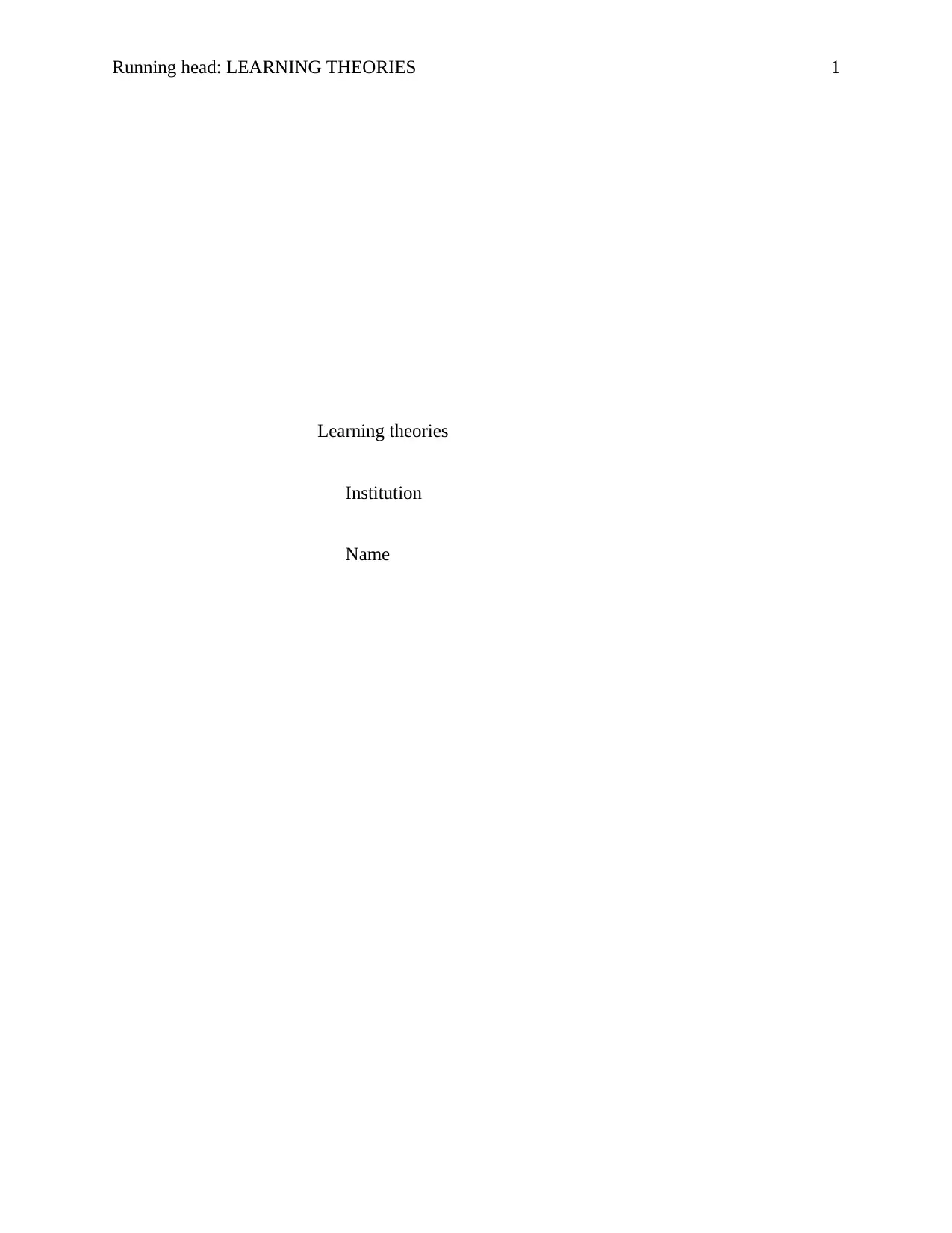
Running head: LEARNING THEORIES 1
Learning theories
Institution
Name
Learning theories
Institution
Name
Secure Best Marks with AI Grader
Need help grading? Try our AI Grader for instant feedback on your assignments.
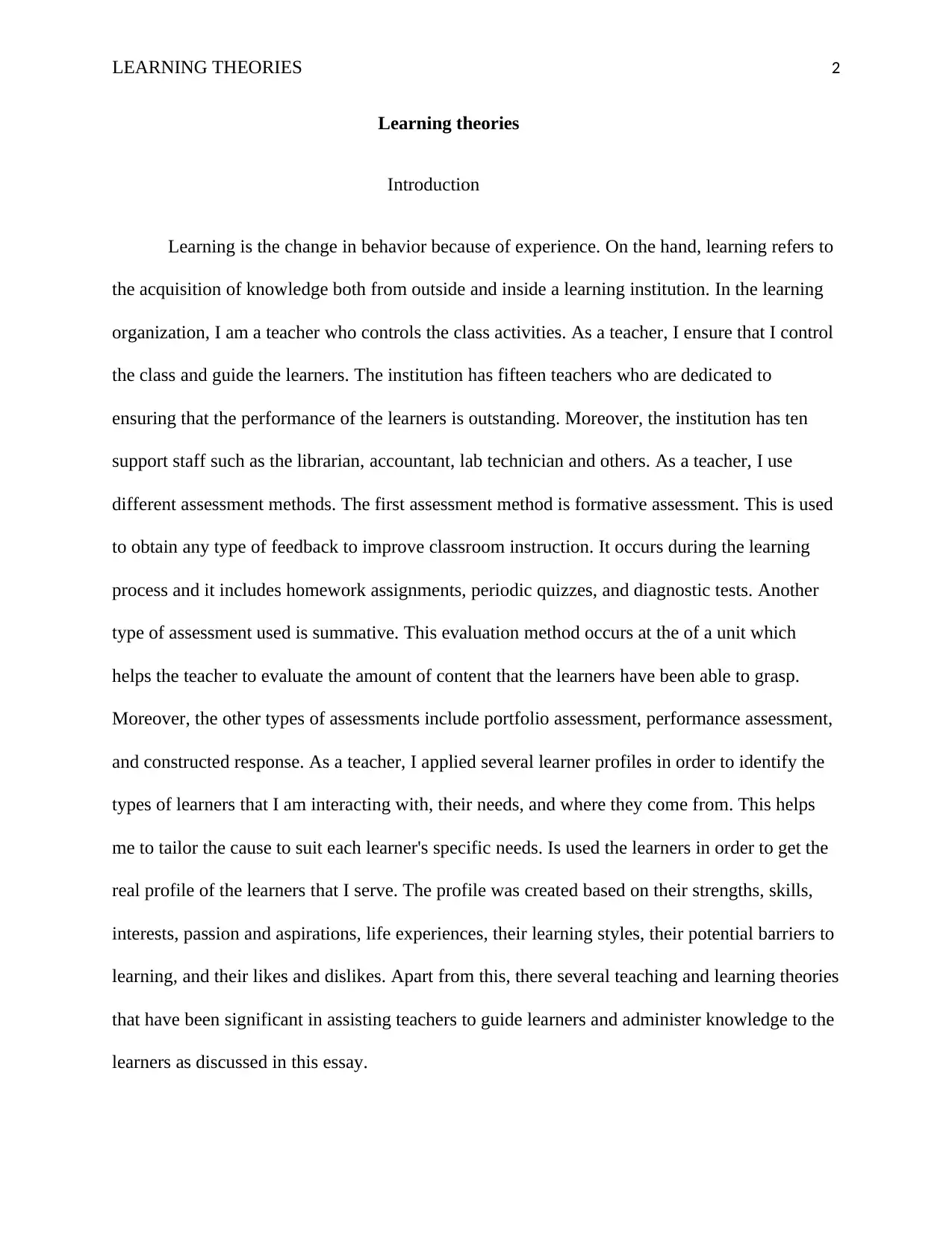
LEARNING THEORIES 2
Learning theories
Introduction
Learning is the change in behavior because of experience. On the hand, learning refers to
the acquisition of knowledge both from outside and inside a learning institution. In the learning
organization, I am a teacher who controls the class activities. As a teacher, I ensure that I control
the class and guide the learners. The institution has fifteen teachers who are dedicated to
ensuring that the performance of the learners is outstanding. Moreover, the institution has ten
support staff such as the librarian, accountant, lab technician and others. As a teacher, I use
different assessment methods. The first assessment method is formative assessment. This is used
to obtain any type of feedback to improve classroom instruction. It occurs during the learning
process and it includes homework assignments, periodic quizzes, and diagnostic tests. Another
type of assessment used is summative. This evaluation method occurs at the of a unit which
helps the teacher to evaluate the amount of content that the learners have been able to grasp.
Moreover, the other types of assessments include portfolio assessment, performance assessment,
and constructed response. As a teacher, I applied several learner profiles in order to identify the
types of learners that I am interacting with, their needs, and where they come from. This helps
me to tailor the cause to suit each learner's specific needs. Is used the learners in order to get the
real profile of the learners that I serve. The profile was created based on their strengths, skills,
interests, passion and aspirations, life experiences, their learning styles, their potential barriers to
learning, and their likes and dislikes. Apart from this, there several teaching and learning theories
that have been significant in assisting teachers to guide learners and administer knowledge to the
learners as discussed in this essay.
Learning theories
Introduction
Learning is the change in behavior because of experience. On the hand, learning refers to
the acquisition of knowledge both from outside and inside a learning institution. In the learning
organization, I am a teacher who controls the class activities. As a teacher, I ensure that I control
the class and guide the learners. The institution has fifteen teachers who are dedicated to
ensuring that the performance of the learners is outstanding. Moreover, the institution has ten
support staff such as the librarian, accountant, lab technician and others. As a teacher, I use
different assessment methods. The first assessment method is formative assessment. This is used
to obtain any type of feedback to improve classroom instruction. It occurs during the learning
process and it includes homework assignments, periodic quizzes, and diagnostic tests. Another
type of assessment used is summative. This evaluation method occurs at the of a unit which
helps the teacher to evaluate the amount of content that the learners have been able to grasp.
Moreover, the other types of assessments include portfolio assessment, performance assessment,
and constructed response. As a teacher, I applied several learner profiles in order to identify the
types of learners that I am interacting with, their needs, and where they come from. This helps
me to tailor the cause to suit each learner's specific needs. Is used the learners in order to get the
real profile of the learners that I serve. The profile was created based on their strengths, skills,
interests, passion and aspirations, life experiences, their learning styles, their potential barriers to
learning, and their likes and dislikes. Apart from this, there several teaching and learning theories
that have been significant in assisting teachers to guide learners and administer knowledge to the
learners as discussed in this essay.
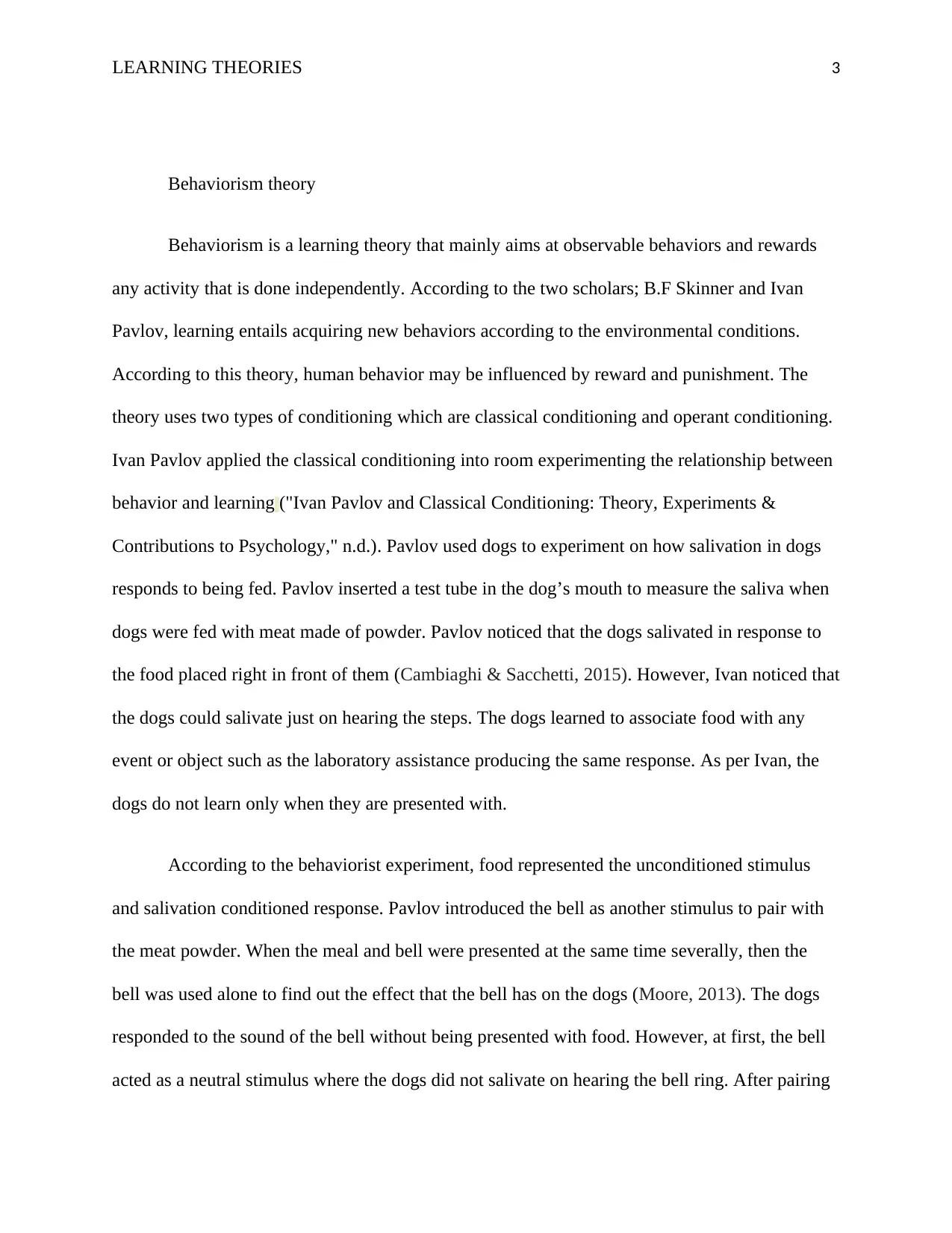
LEARNING THEORIES 3
Behaviorism theory
Behaviorism is a learning theory that mainly aims at observable behaviors and rewards
any activity that is done independently. According to the two scholars; B.F Skinner and Ivan
Pavlov, learning entails acquiring new behaviors according to the environmental conditions.
According to this theory, human behavior may be influenced by reward and punishment. The
theory uses two types of conditioning which are classical conditioning and operant conditioning.
Ivan Pavlov applied the classical conditioning into room experimenting the relationship between
behavior and learning ("Ivan Pavlov and Classical Conditioning: Theory, Experiments &
Contributions to Psychology," n.d.). Pavlov used dogs to experiment on how salivation in dogs
responds to being fed. Pavlov inserted a test tube in the dog’s mouth to measure the saliva when
dogs were fed with meat made of powder. Pavlov noticed that the dogs salivated in response to
the food placed right in front of them (Cambiaghi & Sacchetti, 2015). However, Ivan noticed that
the dogs could salivate just on hearing the steps. The dogs learned to associate food with any
event or object such as the laboratory assistance producing the same response. As per Ivan, the
dogs do not learn only when they are presented with.
According to the behaviorist experiment, food represented the unconditioned stimulus
and salivation conditioned response. Pavlov introduced the bell as another stimulus to pair with
the meat powder. When the meal and bell were presented at the same time severally, then the
bell was used alone to find out the effect that the bell has on the dogs (Moore, 2013). The dogs
responded to the sound of the bell without being presented with food. However, at first, the bell
acted as a neutral stimulus where the dogs did not salivate on hearing the bell ring. After pairing
Behaviorism theory
Behaviorism is a learning theory that mainly aims at observable behaviors and rewards
any activity that is done independently. According to the two scholars; B.F Skinner and Ivan
Pavlov, learning entails acquiring new behaviors according to the environmental conditions.
According to this theory, human behavior may be influenced by reward and punishment. The
theory uses two types of conditioning which are classical conditioning and operant conditioning.
Ivan Pavlov applied the classical conditioning into room experimenting the relationship between
behavior and learning ("Ivan Pavlov and Classical Conditioning: Theory, Experiments &
Contributions to Psychology," n.d.). Pavlov used dogs to experiment on how salivation in dogs
responds to being fed. Pavlov inserted a test tube in the dog’s mouth to measure the saliva when
dogs were fed with meat made of powder. Pavlov noticed that the dogs salivated in response to
the food placed right in front of them (Cambiaghi & Sacchetti, 2015). However, Ivan noticed that
the dogs could salivate just on hearing the steps. The dogs learned to associate food with any
event or object such as the laboratory assistance producing the same response. As per Ivan, the
dogs do not learn only when they are presented with.
According to the behaviorist experiment, food represented the unconditioned stimulus
and salivation conditioned response. Pavlov introduced the bell as another stimulus to pair with
the meat powder. When the meal and bell were presented at the same time severally, then the
bell was used alone to find out the effect that the bell has on the dogs (Moore, 2013). The dogs
responded to the sound of the bell without being presented with food. However, at first, the bell
acted as a neutral stimulus where the dogs did not salivate on hearing the bell ring. After pairing
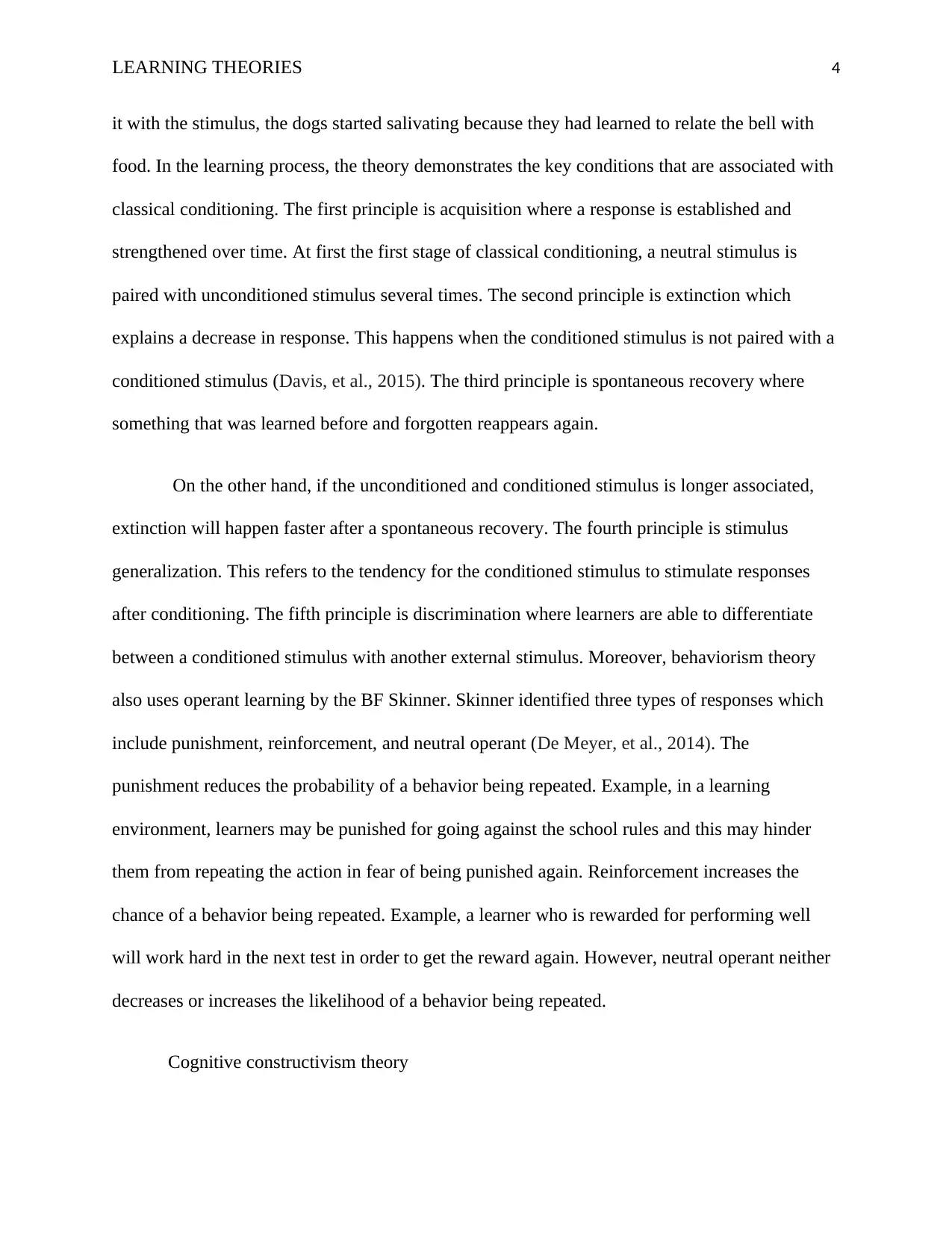
LEARNING THEORIES 4
it with the stimulus, the dogs started salivating because they had learned to relate the bell with
food. In the learning process, the theory demonstrates the key conditions that are associated with
classical conditioning. The first principle is acquisition where a response is established and
strengthened over time. At first the first stage of classical conditioning, a neutral stimulus is
paired with unconditioned stimulus several times. The second principle is extinction which
explains a decrease in response. This happens when the conditioned stimulus is not paired with a
conditioned stimulus (Davis, et al., 2015). The third principle is spontaneous recovery where
something that was learned before and forgotten reappears again.
On the other hand, if the unconditioned and conditioned stimulus is longer associated,
extinction will happen faster after a spontaneous recovery. The fourth principle is stimulus
generalization. This refers to the tendency for the conditioned stimulus to stimulate responses
after conditioning. The fifth principle is discrimination where learners are able to differentiate
between a conditioned stimulus with another external stimulus. Moreover, behaviorism theory
also uses operant learning by the BF Skinner. Skinner identified three types of responses which
include punishment, reinforcement, and neutral operant (De Meyer, et al., 2014). The
punishment reduces the probability of a behavior being repeated. Example, in a learning
environment, learners may be punished for going against the school rules and this may hinder
them from repeating the action in fear of being punished again. Reinforcement increases the
chance of a behavior being repeated. Example, a learner who is rewarded for performing well
will work hard in the next test in order to get the reward again. However, neutral operant neither
decreases or increases the likelihood of a behavior being repeated.
Cognitive constructivism theory
it with the stimulus, the dogs started salivating because they had learned to relate the bell with
food. In the learning process, the theory demonstrates the key conditions that are associated with
classical conditioning. The first principle is acquisition where a response is established and
strengthened over time. At first the first stage of classical conditioning, a neutral stimulus is
paired with unconditioned stimulus several times. The second principle is extinction which
explains a decrease in response. This happens when the conditioned stimulus is not paired with a
conditioned stimulus (Davis, et al., 2015). The third principle is spontaneous recovery where
something that was learned before and forgotten reappears again.
On the other hand, if the unconditioned and conditioned stimulus is longer associated,
extinction will happen faster after a spontaneous recovery. The fourth principle is stimulus
generalization. This refers to the tendency for the conditioned stimulus to stimulate responses
after conditioning. The fifth principle is discrimination where learners are able to differentiate
between a conditioned stimulus with another external stimulus. Moreover, behaviorism theory
also uses operant learning by the BF Skinner. Skinner identified three types of responses which
include punishment, reinforcement, and neutral operant (De Meyer, et al., 2014). The
punishment reduces the probability of a behavior being repeated. Example, in a learning
environment, learners may be punished for going against the school rules and this may hinder
them from repeating the action in fear of being punished again. Reinforcement increases the
chance of a behavior being repeated. Example, a learner who is rewarded for performing well
will work hard in the next test in order to get the reward again. However, neutral operant neither
decreases or increases the likelihood of a behavior being repeated.
Cognitive constructivism theory
Secure Best Marks with AI Grader
Need help grading? Try our AI Grader for instant feedback on your assignments.
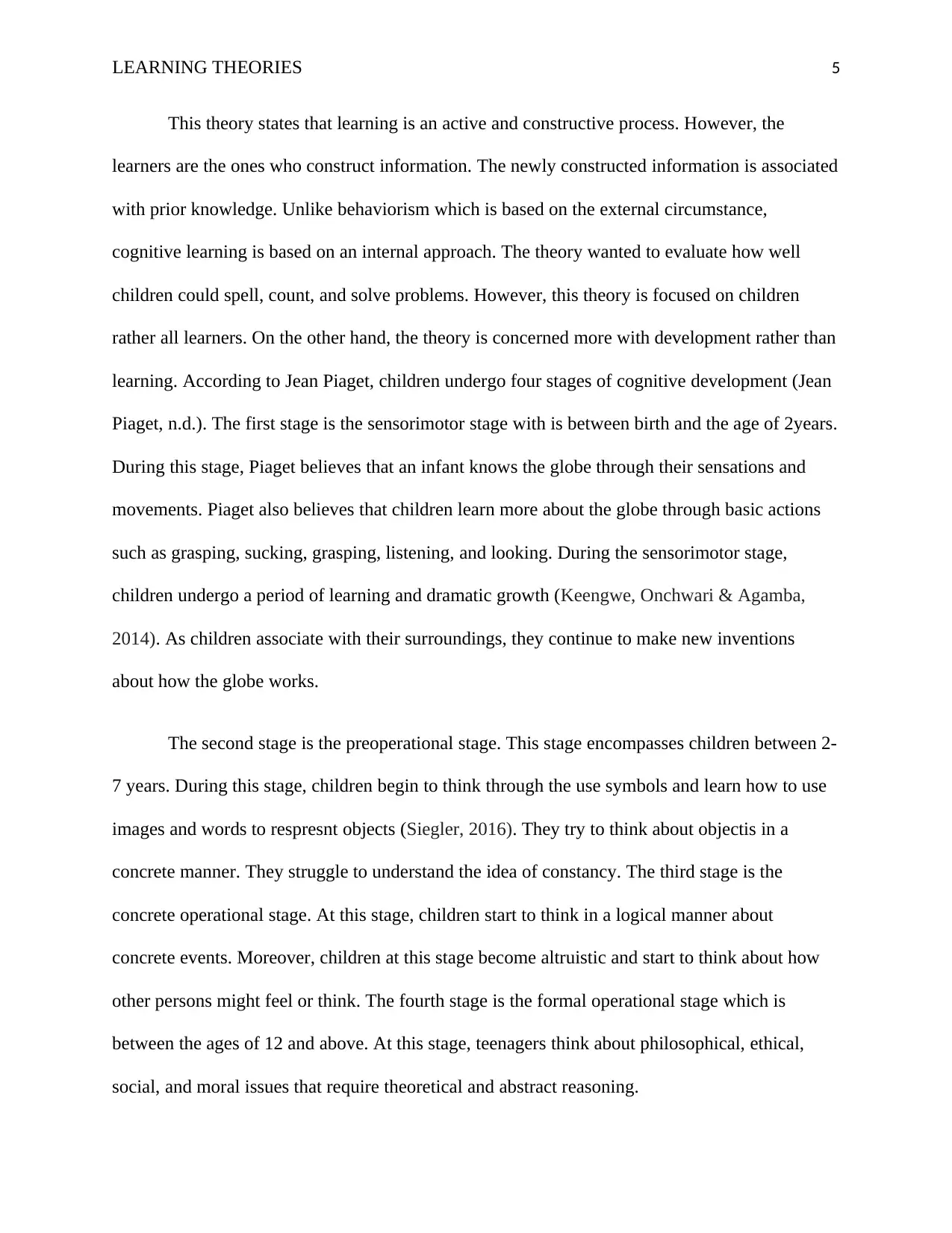
LEARNING THEORIES 5
This theory states that learning is an active and constructive process. However, the
learners are the ones who construct information. The newly constructed information is associated
with prior knowledge. Unlike behaviorism which is based on the external circumstance,
cognitive learning is based on an internal approach. The theory wanted to evaluate how well
children could spell, count, and solve problems. However, this theory is focused on children
rather all learners. On the other hand, the theory is concerned more with development rather than
learning. According to Jean Piaget, children undergo four stages of cognitive development (Jean
Piaget, n.d.). The first stage is the sensorimotor stage with is between birth and the age of 2years.
During this stage, Piaget believes that an infant knows the globe through their sensations and
movements. Piaget also believes that children learn more about the globe through basic actions
such as grasping, sucking, grasping, listening, and looking. During the sensorimotor stage,
children undergo a period of learning and dramatic growth (Keengwe, Onchwari & Agamba,
2014). As children associate with their surroundings, they continue to make new inventions
about how the globe works.
The second stage is the preoperational stage. This stage encompasses children between 2-
7 years. During this stage, children begin to think through the use symbols and learn how to use
images and words to respresnt objects (Siegler, 2016). They try to think about objectis in a
concrete manner. They struggle to understand the idea of constancy. The third stage is the
concrete operational stage. At this stage, children start to think in a logical manner about
concrete events. Moreover, children at this stage become altruistic and start to think about how
other persons might feel or think. The fourth stage is the formal operational stage which is
between the ages of 12 and above. At this stage, teenagers think about philosophical, ethical,
social, and moral issues that require theoretical and abstract reasoning.
This theory states that learning is an active and constructive process. However, the
learners are the ones who construct information. The newly constructed information is associated
with prior knowledge. Unlike behaviorism which is based on the external circumstance,
cognitive learning is based on an internal approach. The theory wanted to evaluate how well
children could spell, count, and solve problems. However, this theory is focused on children
rather all learners. On the other hand, the theory is concerned more with development rather than
learning. According to Jean Piaget, children undergo four stages of cognitive development (Jean
Piaget, n.d.). The first stage is the sensorimotor stage with is between birth and the age of 2years.
During this stage, Piaget believes that an infant knows the globe through their sensations and
movements. Piaget also believes that children learn more about the globe through basic actions
such as grasping, sucking, grasping, listening, and looking. During the sensorimotor stage,
children undergo a period of learning and dramatic growth (Keengwe, Onchwari & Agamba,
2014). As children associate with their surroundings, they continue to make new inventions
about how the globe works.
The second stage is the preoperational stage. This stage encompasses children between 2-
7 years. During this stage, children begin to think through the use symbols and learn how to use
images and words to respresnt objects (Siegler, 2016). They try to think about objectis in a
concrete manner. They struggle to understand the idea of constancy. The third stage is the
concrete operational stage. At this stage, children start to think in a logical manner about
concrete events. Moreover, children at this stage become altruistic and start to think about how
other persons might feel or think. The fourth stage is the formal operational stage which is
between the ages of 12 and above. At this stage, teenagers think about philosophical, ethical,
social, and moral issues that require theoretical and abstract reasoning.
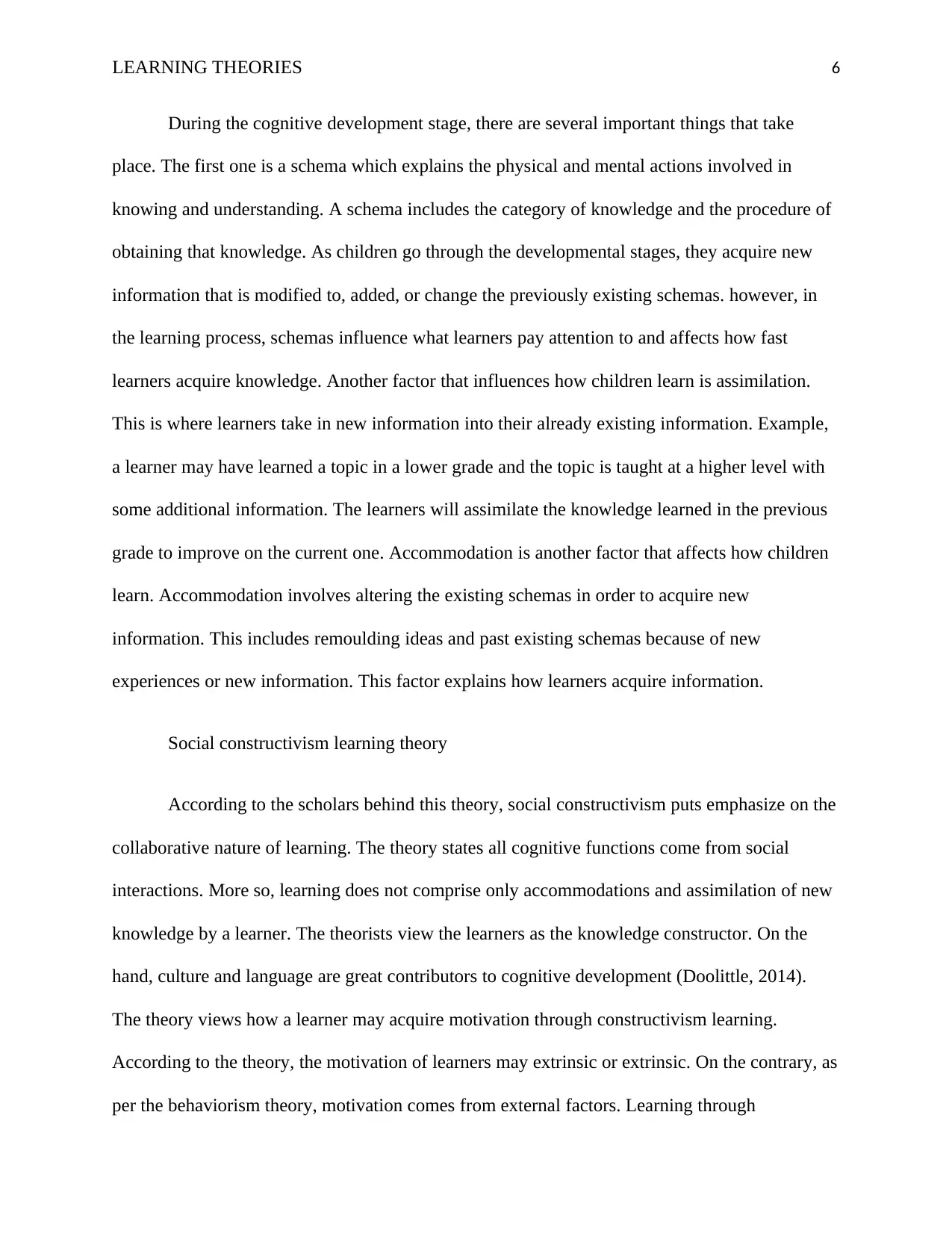
LEARNING THEORIES 6
During the cognitive development stage, there are several important things that take
place. The first one is a schema which explains the physical and mental actions involved in
knowing and understanding. A schema includes the category of knowledge and the procedure of
obtaining that knowledge. As children go through the developmental stages, they acquire new
information that is modified to, added, or change the previously existing schemas. however, in
the learning process, schemas influence what learners pay attention to and affects how fast
learners acquire knowledge. Another factor that influences how children learn is assimilation.
This is where learners take in new information into their already existing information. Example,
a learner may have learned a topic in a lower grade and the topic is taught at a higher level with
some additional information. The learners will assimilate the knowledge learned in the previous
grade to improve on the current one. Accommodation is another factor that affects how children
learn. Accommodation involves altering the existing schemas in order to acquire new
information. This includes remoulding ideas and past existing schemas because of new
experiences or new information. This factor explains how learners acquire information.
Social constructivism learning theory
According to the scholars behind this theory, social constructivism puts emphasize on the
collaborative nature of learning. The theory states all cognitive functions come from social
interactions. More so, learning does not comprise only accommodations and assimilation of new
knowledge by a learner. The theorists view the learners as the knowledge constructor. On the
hand, culture and language are great contributors to cognitive development (Doolittle, 2014).
The theory views how a learner may acquire motivation through constructivism learning.
According to the theory, the motivation of learners may extrinsic or extrinsic. On the contrary, as
per the behaviorism theory, motivation comes from external factors. Learning through
During the cognitive development stage, there are several important things that take
place. The first one is a schema which explains the physical and mental actions involved in
knowing and understanding. A schema includes the category of knowledge and the procedure of
obtaining that knowledge. As children go through the developmental stages, they acquire new
information that is modified to, added, or change the previously existing schemas. however, in
the learning process, schemas influence what learners pay attention to and affects how fast
learners acquire knowledge. Another factor that influences how children learn is assimilation.
This is where learners take in new information into their already existing information. Example,
a learner may have learned a topic in a lower grade and the topic is taught at a higher level with
some additional information. The learners will assimilate the knowledge learned in the previous
grade to improve on the current one. Accommodation is another factor that affects how children
learn. Accommodation involves altering the existing schemas in order to acquire new
information. This includes remoulding ideas and past existing schemas because of new
experiences or new information. This factor explains how learners acquire information.
Social constructivism learning theory
According to the scholars behind this theory, social constructivism puts emphasize on the
collaborative nature of learning. The theory states all cognitive functions come from social
interactions. More so, learning does not comprise only accommodations and assimilation of new
knowledge by a learner. The theorists view the learners as the knowledge constructor. On the
hand, culture and language are great contributors to cognitive development (Doolittle, 2014).
The theory views how a learner may acquire motivation through constructivism learning.
According to the theory, the motivation of learners may extrinsic or extrinsic. On the contrary, as
per the behaviorism theory, motivation comes from external factors. Learning through
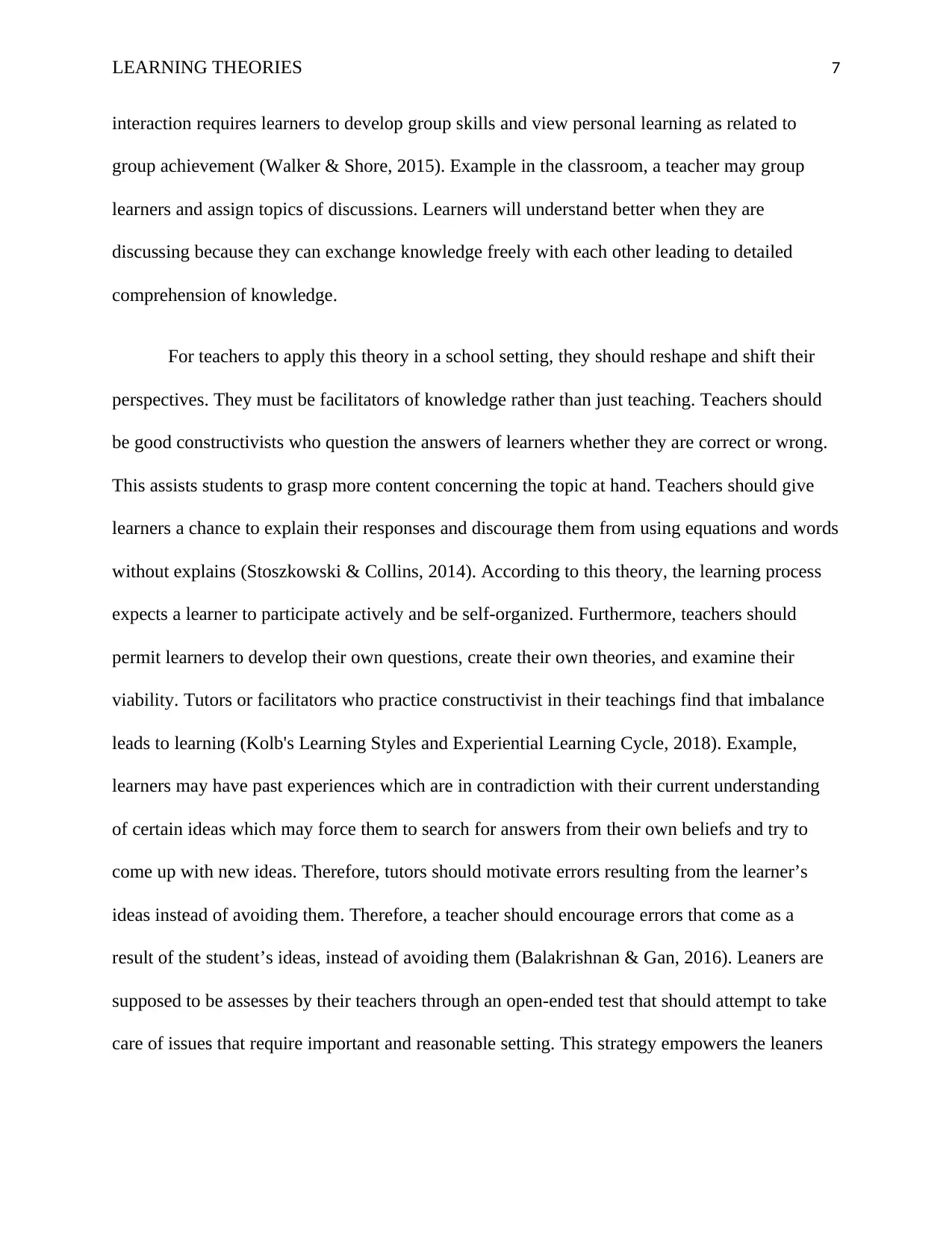
LEARNING THEORIES 7
interaction requires learners to develop group skills and view personal learning as related to
group achievement (Walker & Shore, 2015). Example in the classroom, a teacher may group
learners and assign topics of discussions. Learners will understand better when they are
discussing because they can exchange knowledge freely with each other leading to detailed
comprehension of knowledge.
For teachers to apply this theory in a school setting, they should reshape and shift their
perspectives. They must be facilitators of knowledge rather than just teaching. Teachers should
be good constructivists who question the answers of learners whether they are correct or wrong.
This assists students to grasp more content concerning the topic at hand. Teachers should give
learners a chance to explain their responses and discourage them from using equations and words
without explains (Stoszkowski & Collins, 2014). According to this theory, the learning process
expects a learner to participate actively and be self-organized. Furthermore, teachers should
permit learners to develop their own questions, create their own theories, and examine their
viability. Tutors or facilitators who practice constructivist in their teachings find that imbalance
leads to learning (Kolb's Learning Styles and Experiential Learning Cycle, 2018). Example,
learners may have past experiences which are in contradiction with their current understanding
of certain ideas which may force them to search for answers from their own beliefs and try to
come up with new ideas. Therefore, tutors should motivate errors resulting from the learner’s
ideas instead of avoiding them. Therefore, a teacher should encourage errors that come as a
result of the student’s ideas, instead of avoiding them (Balakrishnan & Gan, 2016). Leaners are
supposed to be assesses by their teachers through an open-ended test that should attempt to take
care of issues that require important and reasonable setting. This strategy empowers the leaners
interaction requires learners to develop group skills and view personal learning as related to
group achievement (Walker & Shore, 2015). Example in the classroom, a teacher may group
learners and assign topics of discussions. Learners will understand better when they are
discussing because they can exchange knowledge freely with each other leading to detailed
comprehension of knowledge.
For teachers to apply this theory in a school setting, they should reshape and shift their
perspectives. They must be facilitators of knowledge rather than just teaching. Teachers should
be good constructivists who question the answers of learners whether they are correct or wrong.
This assists students to grasp more content concerning the topic at hand. Teachers should give
learners a chance to explain their responses and discourage them from using equations and words
without explains (Stoszkowski & Collins, 2014). According to this theory, the learning process
expects a learner to participate actively and be self-organized. Furthermore, teachers should
permit learners to develop their own questions, create their own theories, and examine their
viability. Tutors or facilitators who practice constructivist in their teachings find that imbalance
leads to learning (Kolb's Learning Styles and Experiential Learning Cycle, 2018). Example,
learners may have past experiences which are in contradiction with their current understanding
of certain ideas which may force them to search for answers from their own beliefs and try to
come up with new ideas. Therefore, tutors should motivate errors resulting from the learner’s
ideas instead of avoiding them. Therefore, a teacher should encourage errors that come as a
result of the student’s ideas, instead of avoiding them (Balakrishnan & Gan, 2016). Leaners are
supposed to be assesses by their teachers through an open-ended test that should attempt to take
care of issues that require important and reasonable setting. This strategy empowers the leaners
Paraphrase This Document
Need a fresh take? Get an instant paraphrase of this document with our AI Paraphraser
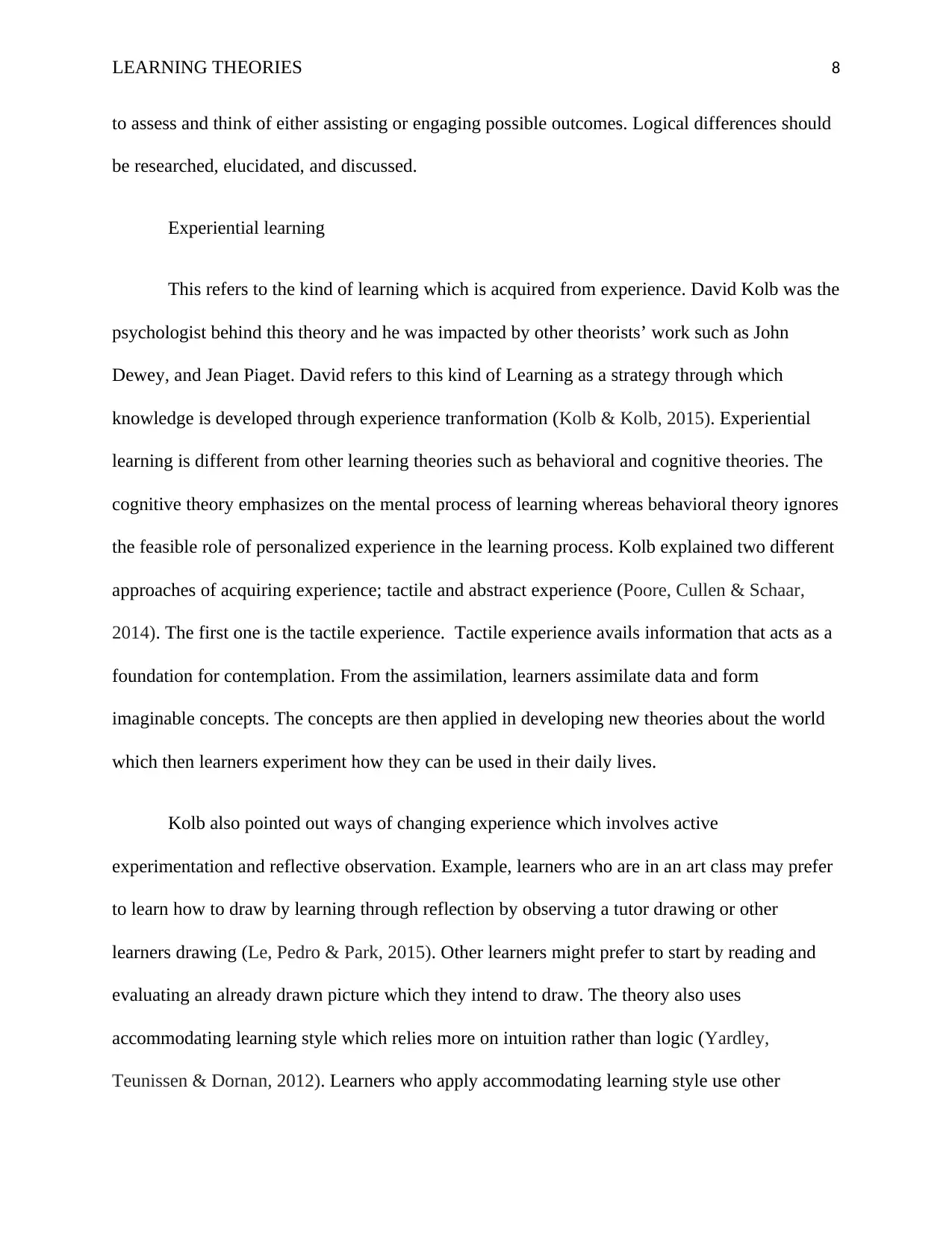
LEARNING THEORIES 8
to assess and think of either assisting or engaging possible outcomes. Logical differences should
be researched, elucidated, and discussed.
Experiential learning
This refers to the kind of learning which is acquired from experience. David Kolb was the
psychologist behind this theory and he was impacted by other theorists’ work such as John
Dewey, and Jean Piaget. David refers to this kind of Learning as a strategy through which
knowledge is developed through experience tranformation (Kolb & Kolb, 2015). Experiential
learning is different from other learning theories such as behavioral and cognitive theories. The
cognitive theory emphasizes on the mental process of learning whereas behavioral theory ignores
the feasible role of personalized experience in the learning process. Kolb explained two different
approaches of acquiring experience; tactile and abstract experience (Poore, Cullen & Schaar,
2014). The first one is the tactile experience. Tactile experience avails information that acts as a
foundation for contemplation. From the assimilation, learners assimilate data and form
imaginable concepts. The concepts are then applied in developing new theories about the world
which then learners experiment how they can be used in their daily lives.
Kolb also pointed out ways of changing experience which involves active
experimentation and reflective observation. Example, learners who are in an art class may prefer
to learn how to draw by learning through reflection by observing a tutor drawing or other
learners drawing (Le, Pedro & Park, 2015). Other learners might prefer to start by reading and
evaluating an already drawn picture which they intend to draw. The theory also uses
accommodating learning style which relies more on intuition rather than logic (Yardley,
Teunissen & Dornan, 2012). Learners who apply accommodating learning style use other
to assess and think of either assisting or engaging possible outcomes. Logical differences should
be researched, elucidated, and discussed.
Experiential learning
This refers to the kind of learning which is acquired from experience. David Kolb was the
psychologist behind this theory and he was impacted by other theorists’ work such as John
Dewey, and Jean Piaget. David refers to this kind of Learning as a strategy through which
knowledge is developed through experience tranformation (Kolb & Kolb, 2015). Experiential
learning is different from other learning theories such as behavioral and cognitive theories. The
cognitive theory emphasizes on the mental process of learning whereas behavioral theory ignores
the feasible role of personalized experience in the learning process. Kolb explained two different
approaches of acquiring experience; tactile and abstract experience (Poore, Cullen & Schaar,
2014). The first one is the tactile experience. Tactile experience avails information that acts as a
foundation for contemplation. From the assimilation, learners assimilate data and form
imaginable concepts. The concepts are then applied in developing new theories about the world
which then learners experiment how they can be used in their daily lives.
Kolb also pointed out ways of changing experience which involves active
experimentation and reflective observation. Example, learners who are in an art class may prefer
to learn how to draw by learning through reflection by observing a tutor drawing or other
learners drawing (Le, Pedro & Park, 2015). Other learners might prefer to start by reading and
evaluating an already drawn picture which they intend to draw. The theory also uses
accommodating learning style which relies more on intuition rather than logic (Yardley,
Teunissen & Dornan, 2012). Learners who apply accommodating learning style use other
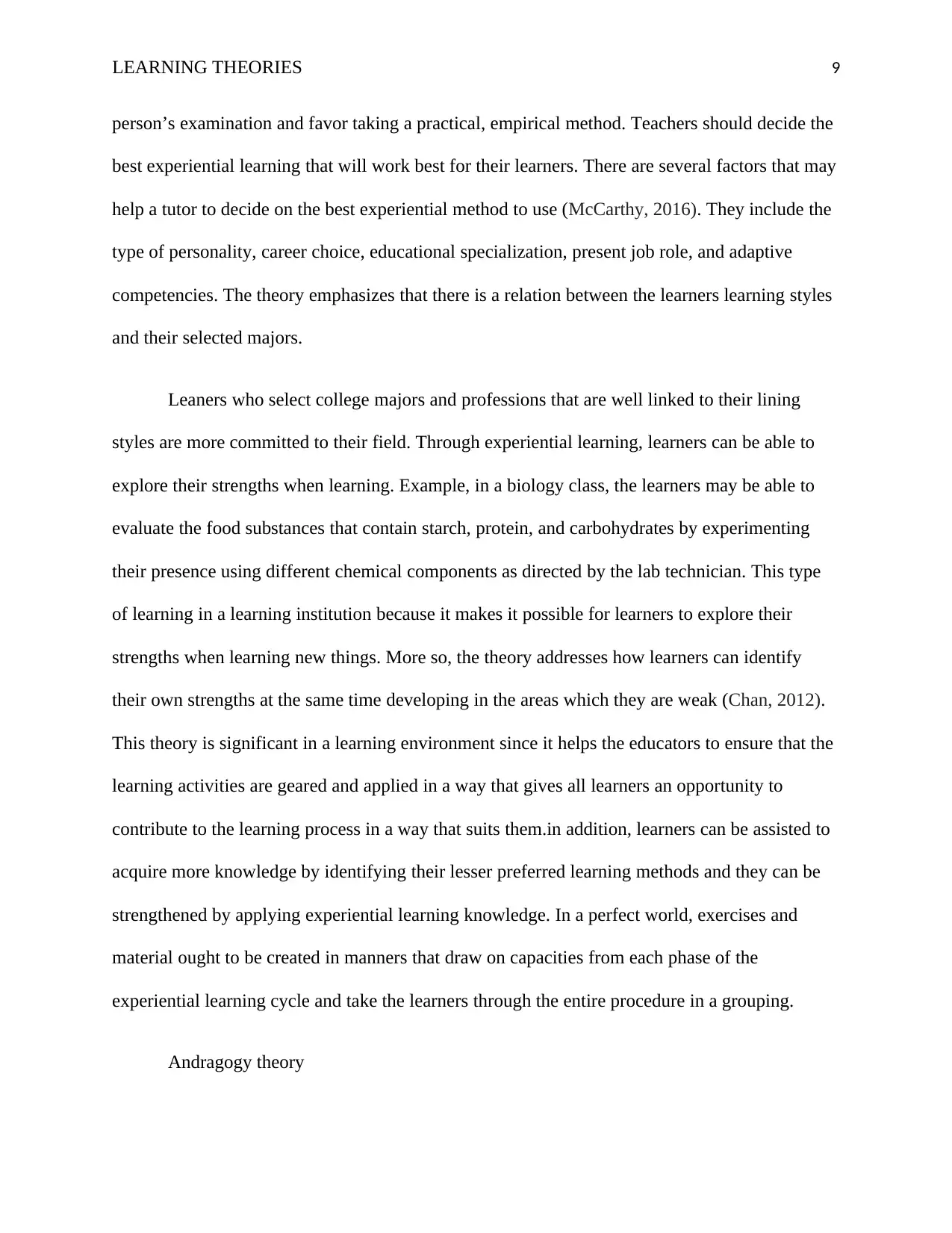
LEARNING THEORIES 9
person’s examination and favor taking a practical, empirical method. Teachers should decide the
best experiential learning that will work best for their learners. There are several factors that may
help a tutor to decide on the best experiential method to use (McCarthy, 2016). They include the
type of personality, career choice, educational specialization, present job role, and adaptive
competencies. The theory emphasizes that there is a relation between the learners learning styles
and their selected majors.
Leaners who select college majors and professions that are well linked to their lining
styles are more committed to their field. Through experiential learning, learners can be able to
explore their strengths when learning. Example, in a biology class, the learners may be able to
evaluate the food substances that contain starch, protein, and carbohydrates by experimenting
their presence using different chemical components as directed by the lab technician. This type
of learning in a learning institution because it makes it possible for learners to explore their
strengths when learning new things. More so, the theory addresses how learners can identify
their own strengths at the same time developing in the areas which they are weak (Chan, 2012).
This theory is significant in a learning environment since it helps the educators to ensure that the
learning activities are geared and applied in a way that gives all learners an opportunity to
contribute to the learning process in a way that suits them.in addition, learners can be assisted to
acquire more knowledge by identifying their lesser preferred learning methods and they can be
strengthened by applying experiential learning knowledge. In a perfect world, exercises and
material ought to be created in manners that draw on capacities from each phase of the
experiential learning cycle and take the learners through the entire procedure in a grouping.
Andragogy theory
person’s examination and favor taking a practical, empirical method. Teachers should decide the
best experiential learning that will work best for their learners. There are several factors that may
help a tutor to decide on the best experiential method to use (McCarthy, 2016). They include the
type of personality, career choice, educational specialization, present job role, and adaptive
competencies. The theory emphasizes that there is a relation between the learners learning styles
and their selected majors.
Leaners who select college majors and professions that are well linked to their lining
styles are more committed to their field. Through experiential learning, learners can be able to
explore their strengths when learning. Example, in a biology class, the learners may be able to
evaluate the food substances that contain starch, protein, and carbohydrates by experimenting
their presence using different chemical components as directed by the lab technician. This type
of learning in a learning institution because it makes it possible for learners to explore their
strengths when learning new things. More so, the theory addresses how learners can identify
their own strengths at the same time developing in the areas which they are weak (Chan, 2012).
This theory is significant in a learning environment since it helps the educators to ensure that the
learning activities are geared and applied in a way that gives all learners an opportunity to
contribute to the learning process in a way that suits them.in addition, learners can be assisted to
acquire more knowledge by identifying their lesser preferred learning methods and they can be
strengthened by applying experiential learning knowledge. In a perfect world, exercises and
material ought to be created in manners that draw on capacities from each phase of the
experiential learning cycle and take the learners through the entire procedure in a grouping.
Andragogy theory
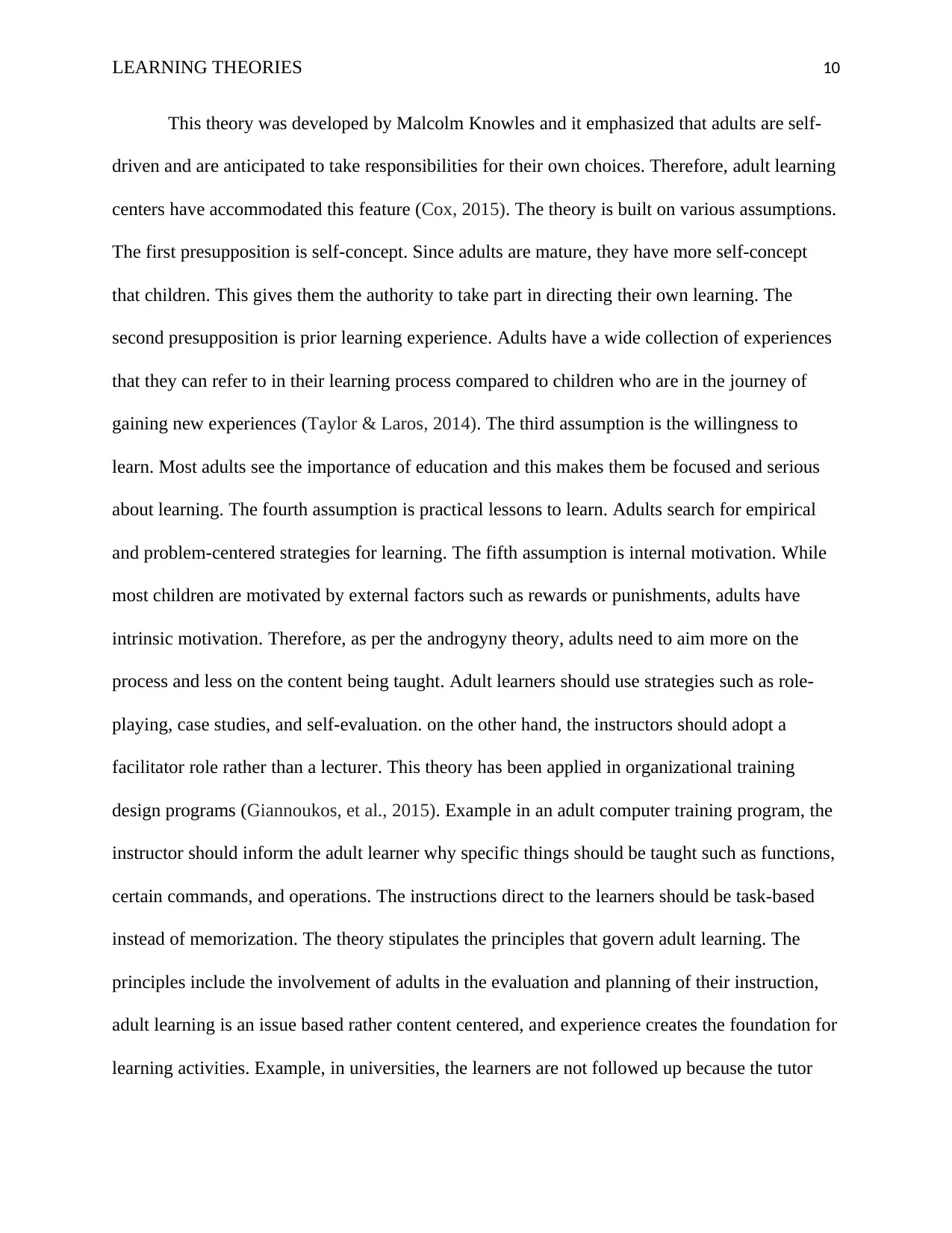
LEARNING THEORIES 10
This theory was developed by Malcolm Knowles and it emphasized that adults are self-
driven and are anticipated to take responsibilities for their own choices. Therefore, adult learning
centers have accommodated this feature (Cox, 2015). The theory is built on various assumptions.
The first presupposition is self-concept. Since adults are mature, they have more self-concept
that children. This gives them the authority to take part in directing their own learning. The
second presupposition is prior learning experience. Adults have a wide collection of experiences
that they can refer to in their learning process compared to children who are in the journey of
gaining new experiences (Taylor & Laros, 2014). The third assumption is the willingness to
learn. Most adults see the importance of education and this makes them be focused and serious
about learning. The fourth assumption is practical lessons to learn. Adults search for empirical
and problem-centered strategies for learning. The fifth assumption is internal motivation. While
most children are motivated by external factors such as rewards or punishments, adults have
intrinsic motivation. Therefore, as per the androgyny theory, adults need to aim more on the
process and less on the content being taught. Adult learners should use strategies such as role-
playing, case studies, and self-evaluation. on the other hand, the instructors should adopt a
facilitator role rather than a lecturer. This theory has been applied in organizational training
design programs (Giannoukos, et al., 2015). Example in an adult computer training program, the
instructor should inform the adult learner why specific things should be taught such as functions,
certain commands, and operations. The instructions direct to the learners should be task-based
instead of memorization. The theory stipulates the principles that govern adult learning. The
principles include the involvement of adults in the evaluation and planning of their instruction,
adult learning is an issue based rather content centered, and experience creates the foundation for
learning activities. Example, in universities, the learners are not followed up because the tutor
This theory was developed by Malcolm Knowles and it emphasized that adults are self-
driven and are anticipated to take responsibilities for their own choices. Therefore, adult learning
centers have accommodated this feature (Cox, 2015). The theory is built on various assumptions.
The first presupposition is self-concept. Since adults are mature, they have more self-concept
that children. This gives them the authority to take part in directing their own learning. The
second presupposition is prior learning experience. Adults have a wide collection of experiences
that they can refer to in their learning process compared to children who are in the journey of
gaining new experiences (Taylor & Laros, 2014). The third assumption is the willingness to
learn. Most adults see the importance of education and this makes them be focused and serious
about learning. The fourth assumption is practical lessons to learn. Adults search for empirical
and problem-centered strategies for learning. The fifth assumption is internal motivation. While
most children are motivated by external factors such as rewards or punishments, adults have
intrinsic motivation. Therefore, as per the androgyny theory, adults need to aim more on the
process and less on the content being taught. Adult learners should use strategies such as role-
playing, case studies, and self-evaluation. on the other hand, the instructors should adopt a
facilitator role rather than a lecturer. This theory has been applied in organizational training
design programs (Giannoukos, et al., 2015). Example in an adult computer training program, the
instructor should inform the adult learner why specific things should be taught such as functions,
certain commands, and operations. The instructions direct to the learners should be task-based
instead of memorization. The theory stipulates the principles that govern adult learning. The
principles include the involvement of adults in the evaluation and planning of their instruction,
adult learning is an issue based rather content centered, and experience creates the foundation for
learning activities. Example, in universities, the learners are not followed up because the tutor
Secure Best Marks with AI Grader
Need help grading? Try our AI Grader for instant feedback on your assignments.
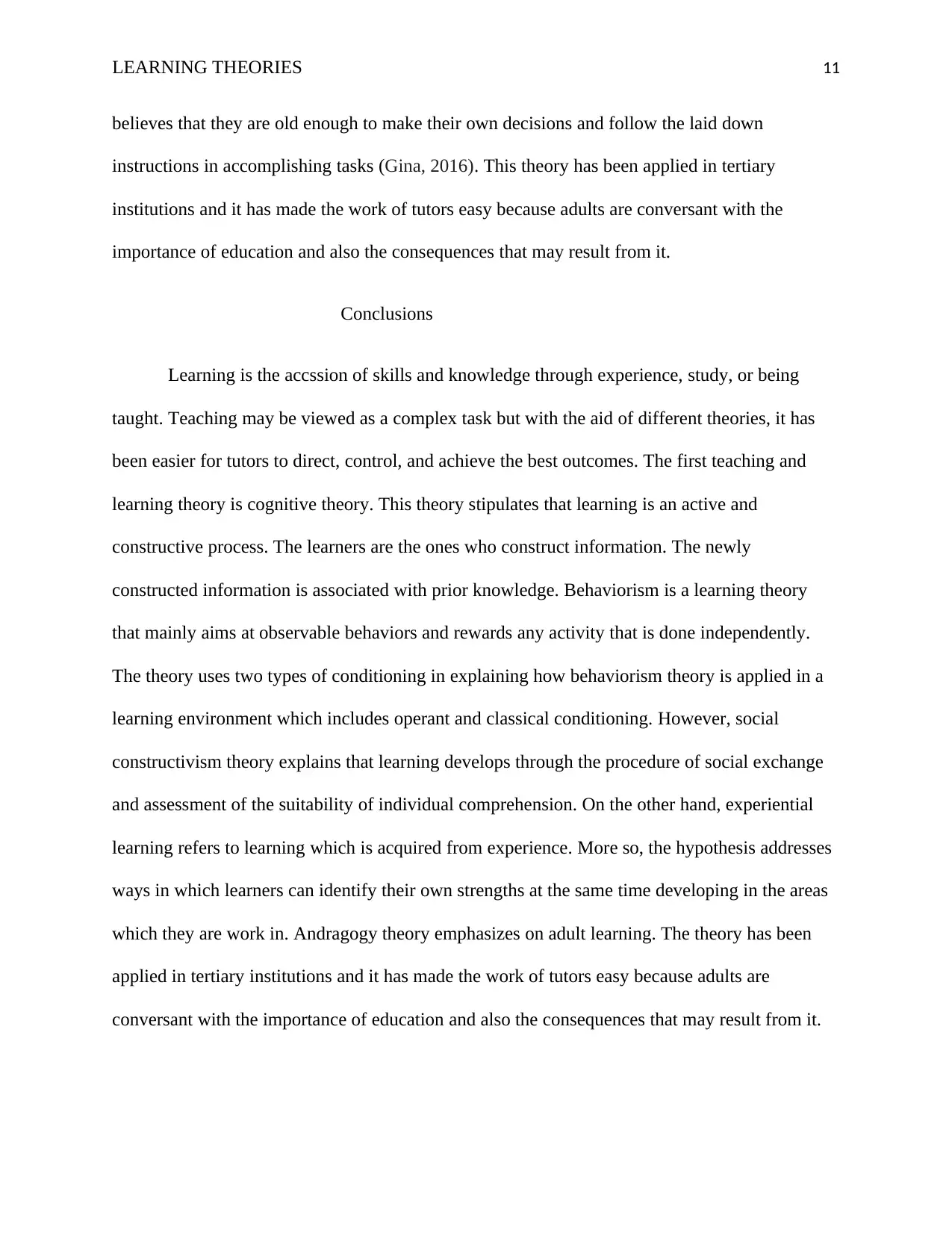
LEARNING THEORIES 11
believes that they are old enough to make their own decisions and follow the laid down
instructions in accomplishing tasks (Gina, 2016). This theory has been applied in tertiary
institutions and it has made the work of tutors easy because adults are conversant with the
importance of education and also the consequences that may result from it.
Conclusions
Learning is the accssion of skills and knowledge through experience, study, or being
taught. Teaching may be viewed as a complex task but with the aid of different theories, it has
been easier for tutors to direct, control, and achieve the best outcomes. The first teaching and
learning theory is cognitive theory. This theory stipulates that learning is an active and
constructive process. The learners are the ones who construct information. The newly
constructed information is associated with prior knowledge. Behaviorism is a learning theory
that mainly aims at observable behaviors and rewards any activity that is done independently.
The theory uses two types of conditioning in explaining how behaviorism theory is applied in a
learning environment which includes operant and classical conditioning. However, social
constructivism theory explains that learning develops through the procedure of social exchange
and assessment of the suitability of individual comprehension. On the other hand, experiential
learning refers to learning which is acquired from experience. More so, the hypothesis addresses
ways in which learners can identify their own strengths at the same time developing in the areas
which they are work in. Andragogy theory emphasizes on adult learning. The theory has been
applied in tertiary institutions and it has made the work of tutors easy because adults are
conversant with the importance of education and also the consequences that may result from it.
believes that they are old enough to make their own decisions and follow the laid down
instructions in accomplishing tasks (Gina, 2016). This theory has been applied in tertiary
institutions and it has made the work of tutors easy because adults are conversant with the
importance of education and also the consequences that may result from it.
Conclusions
Learning is the accssion of skills and knowledge through experience, study, or being
taught. Teaching may be viewed as a complex task but with the aid of different theories, it has
been easier for tutors to direct, control, and achieve the best outcomes. The first teaching and
learning theory is cognitive theory. This theory stipulates that learning is an active and
constructive process. The learners are the ones who construct information. The newly
constructed information is associated with prior knowledge. Behaviorism is a learning theory
that mainly aims at observable behaviors and rewards any activity that is done independently.
The theory uses two types of conditioning in explaining how behaviorism theory is applied in a
learning environment which includes operant and classical conditioning. However, social
constructivism theory explains that learning develops through the procedure of social exchange
and assessment of the suitability of individual comprehension. On the other hand, experiential
learning refers to learning which is acquired from experience. More so, the hypothesis addresses
ways in which learners can identify their own strengths at the same time developing in the areas
which they are work in. Andragogy theory emphasizes on adult learning. The theory has been
applied in tertiary institutions and it has made the work of tutors easy because adults are
conversant with the importance of education and also the consequences that may result from it.
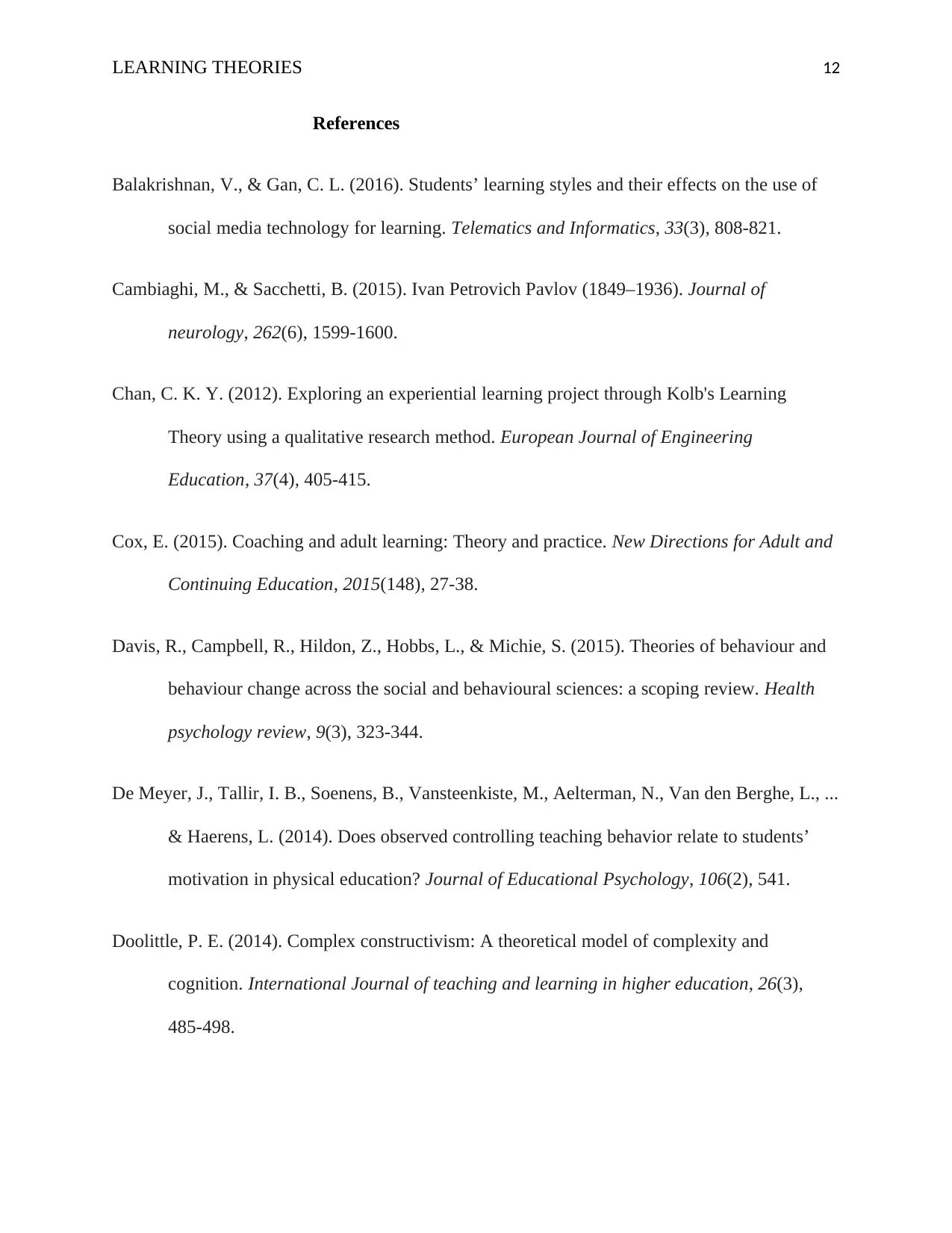
LEARNING THEORIES 12
References
Balakrishnan, V., & Gan, C. L. (2016). Students’ learning styles and their effects on the use of
social media technology for learning. Telematics and Informatics, 33(3), 808-821.
Cambiaghi, M., & Sacchetti, B. (2015). Ivan Petrovich Pavlov (1849–1936). Journal of
neurology, 262(6), 1599-1600.
Chan, C. K. Y. (2012). Exploring an experiential learning project through Kolb's Learning
Theory using a qualitative research method. European Journal of Engineering
Education, 37(4), 405-415.
Cox, E. (2015). Coaching and adult learning: Theory and practice. New Directions for Adult and
Continuing Education, 2015(148), 27-38.
Davis, R., Campbell, R., Hildon, Z., Hobbs, L., & Michie, S. (2015). Theories of behaviour and
behaviour change across the social and behavioural sciences: a scoping review. Health
psychology review, 9(3), 323-344.
De Meyer, J., Tallir, I. B., Soenens, B., Vansteenkiste, M., Aelterman, N., Van den Berghe, L., ...
& Haerens, L. (2014). Does observed controlling teaching behavior relate to students’
motivation in physical education? Journal of Educational Psychology, 106(2), 541.
Doolittle, P. E. (2014). Complex constructivism: A theoretical model of complexity and
cognition. International Journal of teaching and learning in higher education, 26(3),
485-498.
References
Balakrishnan, V., & Gan, C. L. (2016). Students’ learning styles and their effects on the use of
social media technology for learning. Telematics and Informatics, 33(3), 808-821.
Cambiaghi, M., & Sacchetti, B. (2015). Ivan Petrovich Pavlov (1849–1936). Journal of
neurology, 262(6), 1599-1600.
Chan, C. K. Y. (2012). Exploring an experiential learning project through Kolb's Learning
Theory using a qualitative research method. European Journal of Engineering
Education, 37(4), 405-415.
Cox, E. (2015). Coaching and adult learning: Theory and practice. New Directions for Adult and
Continuing Education, 2015(148), 27-38.
Davis, R., Campbell, R., Hildon, Z., Hobbs, L., & Michie, S. (2015). Theories of behaviour and
behaviour change across the social and behavioural sciences: a scoping review. Health
psychology review, 9(3), 323-344.
De Meyer, J., Tallir, I. B., Soenens, B., Vansteenkiste, M., Aelterman, N., Van den Berghe, L., ...
& Haerens, L. (2014). Does observed controlling teaching behavior relate to students’
motivation in physical education? Journal of Educational Psychology, 106(2), 541.
Doolittle, P. E. (2014). Complex constructivism: A theoretical model of complexity and
cognition. International Journal of teaching and learning in higher education, 26(3),
485-498.
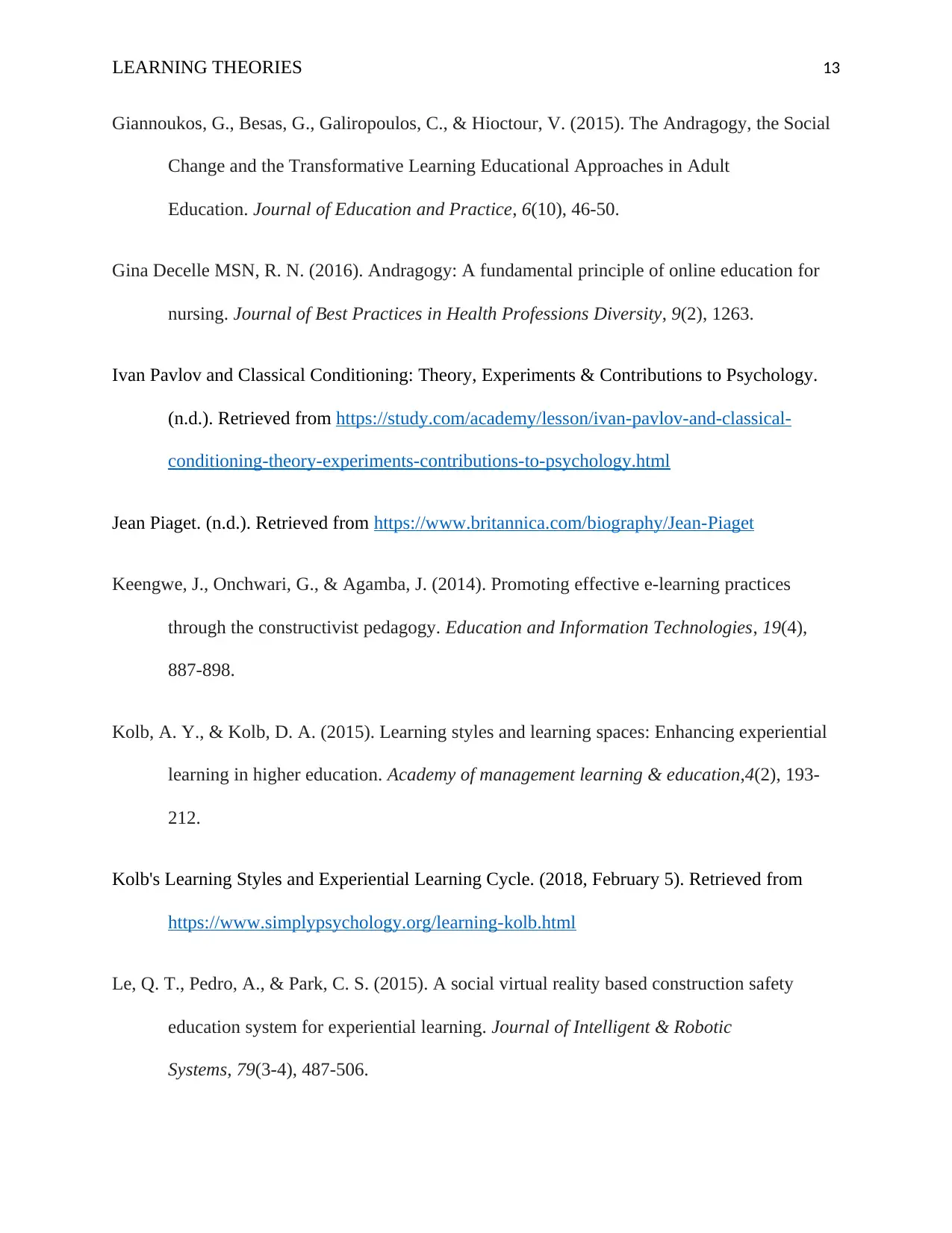
LEARNING THEORIES 13
Giannoukos, G., Besas, G., Galiropoulos, C., & Hioctour, V. (2015). The Andragogy, the Social
Change and the Transformative Learning Educational Approaches in Adult
Education. Journal of Education and Practice, 6(10), 46-50.
Gina Decelle MSN, R. N. (2016). Andragogy: A fundamental principle of online education for
nursing. Journal of Best Practices in Health Professions Diversity, 9(2), 1263.
Ivan Pavlov and Classical Conditioning: Theory, Experiments & Contributions to Psychology.
(n.d.). Retrieved from https://study.com/academy/lesson/ivan-pavlov-and-classical-
conditioning-theory-experiments-contributions-to-psychology.html
Jean Piaget. (n.d.). Retrieved from https://www.britannica.com/biography/Jean-Piaget
Keengwe, J., Onchwari, G., & Agamba, J. (2014). Promoting effective e-learning practices
through the constructivist pedagogy. Education and Information Technologies, 19(4),
887-898.
Kolb, A. Y., & Kolb, D. A. (2015). Learning styles and learning spaces: Enhancing experiential
learning in higher education. Academy of management learning & education,4(2), 193-
212.
Kolb's Learning Styles and Experiential Learning Cycle. (2018, February 5). Retrieved from
https://www.simplypsychology.org/learning-kolb.html
Le, Q. T., Pedro, A., & Park, C. S. (2015). A social virtual reality based construction safety
education system for experiential learning. Journal of Intelligent & Robotic
Systems, 79(3-4), 487-506.
Giannoukos, G., Besas, G., Galiropoulos, C., & Hioctour, V. (2015). The Andragogy, the Social
Change and the Transformative Learning Educational Approaches in Adult
Education. Journal of Education and Practice, 6(10), 46-50.
Gina Decelle MSN, R. N. (2016). Andragogy: A fundamental principle of online education for
nursing. Journal of Best Practices in Health Professions Diversity, 9(2), 1263.
Ivan Pavlov and Classical Conditioning: Theory, Experiments & Contributions to Psychology.
(n.d.). Retrieved from https://study.com/academy/lesson/ivan-pavlov-and-classical-
conditioning-theory-experiments-contributions-to-psychology.html
Jean Piaget. (n.d.). Retrieved from https://www.britannica.com/biography/Jean-Piaget
Keengwe, J., Onchwari, G., & Agamba, J. (2014). Promoting effective e-learning practices
through the constructivist pedagogy. Education and Information Technologies, 19(4),
887-898.
Kolb, A. Y., & Kolb, D. A. (2015). Learning styles and learning spaces: Enhancing experiential
learning in higher education. Academy of management learning & education,4(2), 193-
212.
Kolb's Learning Styles and Experiential Learning Cycle. (2018, February 5). Retrieved from
https://www.simplypsychology.org/learning-kolb.html
Le, Q. T., Pedro, A., & Park, C. S. (2015). A social virtual reality based construction safety
education system for experiential learning. Journal of Intelligent & Robotic
Systems, 79(3-4), 487-506.
Paraphrase This Document
Need a fresh take? Get an instant paraphrase of this document with our AI Paraphraser
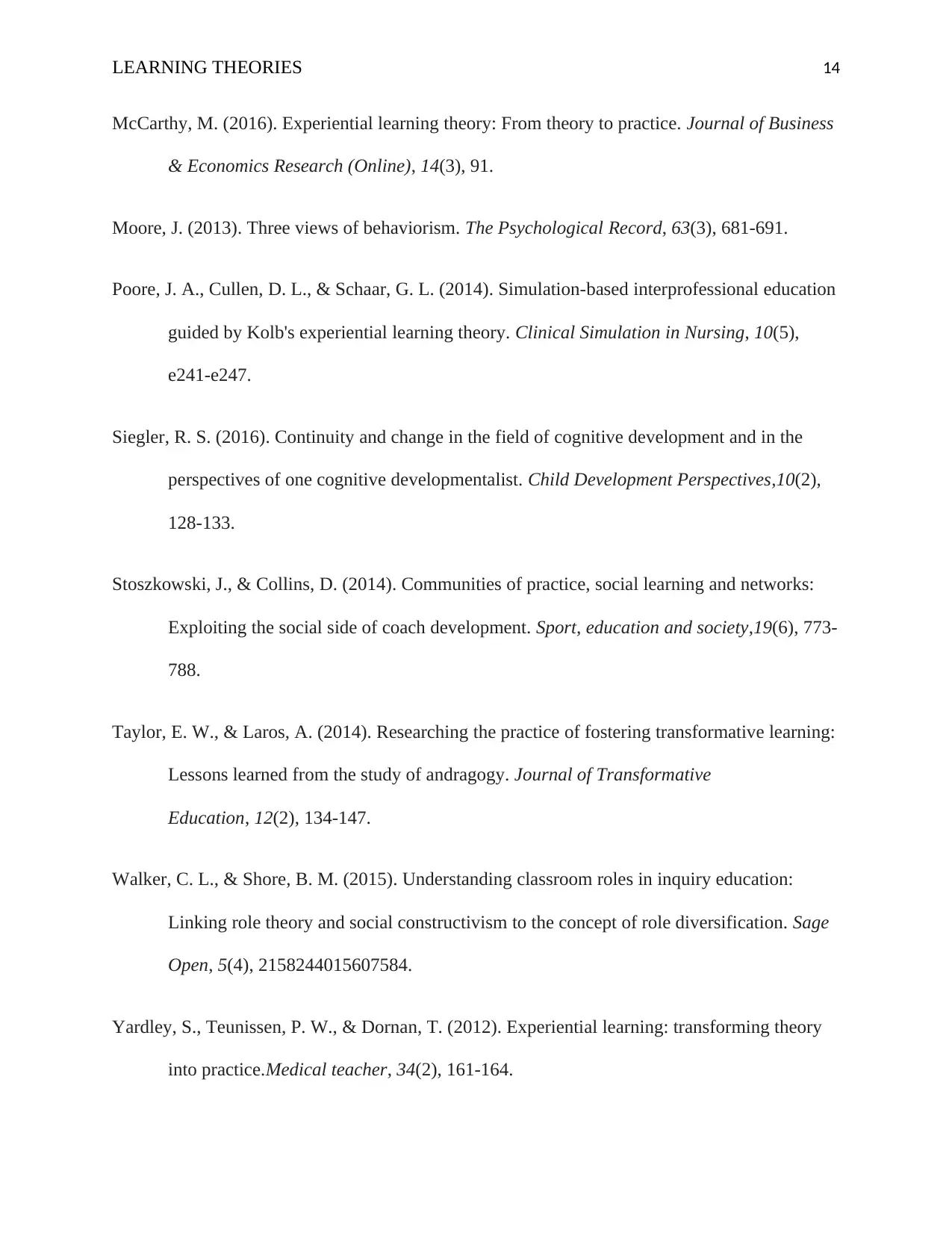
LEARNING THEORIES 14
McCarthy, M. (2016). Experiential learning theory: From theory to practice. Journal of Business
& Economics Research (Online), 14(3), 91.
Moore, J. (2013). Three views of behaviorism. The Psychological Record, 63(3), 681-691.
Poore, J. A., Cullen, D. L., & Schaar, G. L. (2014). Simulation-based interprofessional education
guided by Kolb's experiential learning theory. Clinical Simulation in Nursing, 10(5),
e241-e247.
Siegler, R. S. (2016). Continuity and change in the field of cognitive development and in the
perspectives of one cognitive developmentalist. Child Development Perspectives,10(2),
128-133.
Stoszkowski, J., & Collins, D. (2014). Communities of practice, social learning and networks:
Exploiting the social side of coach development. Sport, education and society,19(6), 773-
788.
Taylor, E. W., & Laros, A. (2014). Researching the practice of fostering transformative learning:
Lessons learned from the study of andragogy. Journal of Transformative
Education, 12(2), 134-147.
Walker, C. L., & Shore, B. M. (2015). Understanding classroom roles in inquiry education:
Linking role theory and social constructivism to the concept of role diversification. Sage
Open, 5(4), 2158244015607584.
Yardley, S., Teunissen, P. W., & Dornan, T. (2012). Experiential learning: transforming theory
into practice.Medical teacher, 34(2), 161-164.
McCarthy, M. (2016). Experiential learning theory: From theory to practice. Journal of Business
& Economics Research (Online), 14(3), 91.
Moore, J. (2013). Three views of behaviorism. The Psychological Record, 63(3), 681-691.
Poore, J. A., Cullen, D. L., & Schaar, G. L. (2014). Simulation-based interprofessional education
guided by Kolb's experiential learning theory. Clinical Simulation in Nursing, 10(5),
e241-e247.
Siegler, R. S. (2016). Continuity and change in the field of cognitive development and in the
perspectives of one cognitive developmentalist. Child Development Perspectives,10(2),
128-133.
Stoszkowski, J., & Collins, D. (2014). Communities of practice, social learning and networks:
Exploiting the social side of coach development. Sport, education and society,19(6), 773-
788.
Taylor, E. W., & Laros, A. (2014). Researching the practice of fostering transformative learning:
Lessons learned from the study of andragogy. Journal of Transformative
Education, 12(2), 134-147.
Walker, C. L., & Shore, B. M. (2015). Understanding classroom roles in inquiry education:
Linking role theory and social constructivism to the concept of role diversification. Sage
Open, 5(4), 2158244015607584.
Yardley, S., Teunissen, P. W., & Dornan, T. (2012). Experiential learning: transforming theory
into practice.Medical teacher, 34(2), 161-164.
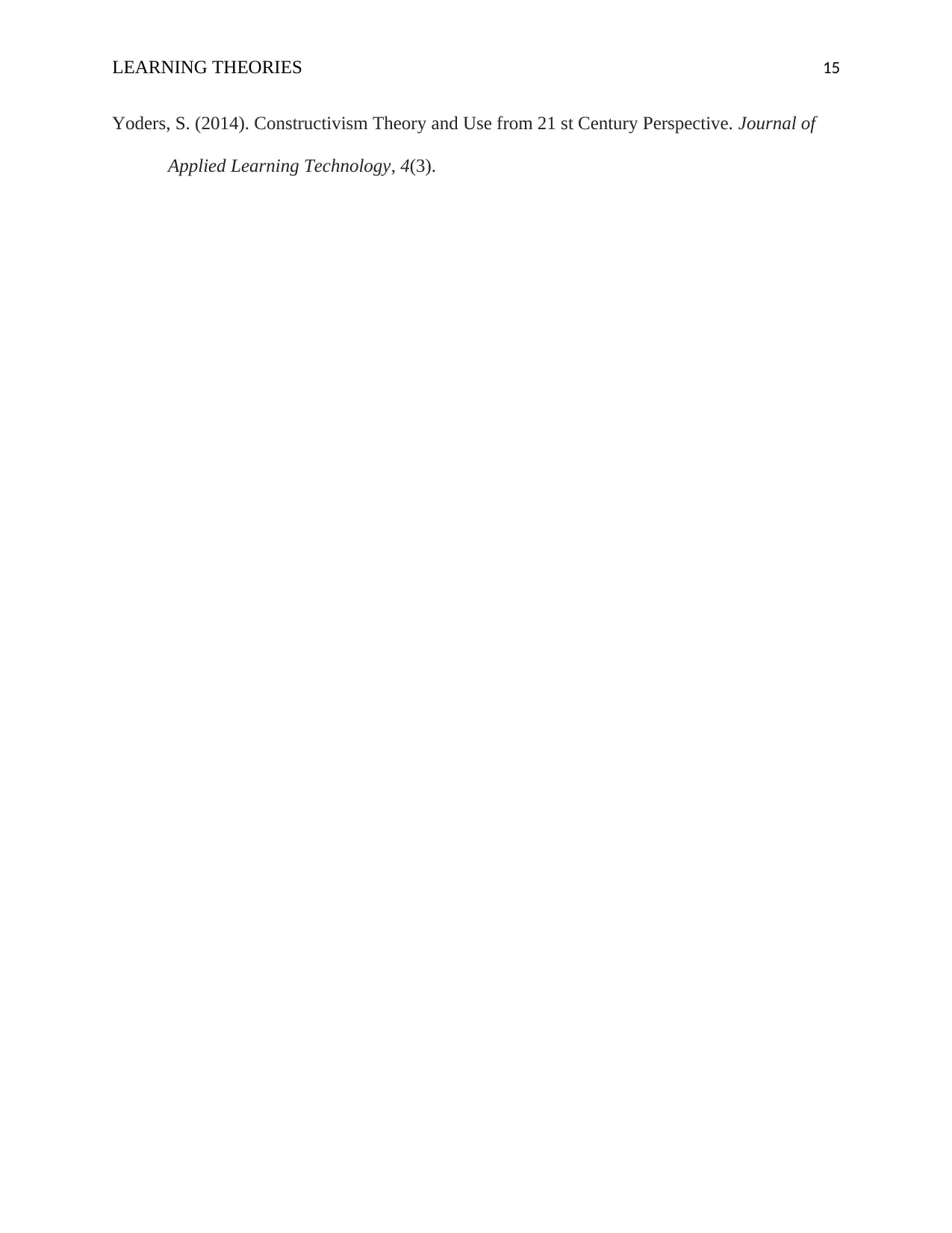
LEARNING THEORIES 15
Yoders, S. (2014). Constructivism Theory and Use from 21 st Century Perspective. Journal of
Applied Learning Technology, 4(3).
Yoders, S. (2014). Constructivism Theory and Use from 21 st Century Perspective. Journal of
Applied Learning Technology, 4(3).
1 out of 15
Related Documents
Your All-in-One AI-Powered Toolkit for Academic Success.
+13062052269
info@desklib.com
Available 24*7 on WhatsApp / Email
![[object Object]](/_next/static/media/star-bottom.7253800d.svg)
Unlock your academic potential
© 2024 | Zucol Services PVT LTD | All rights reserved.





